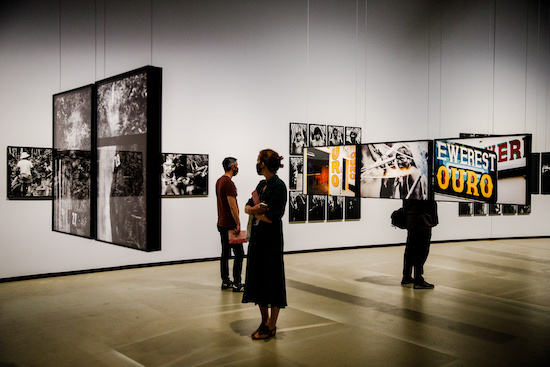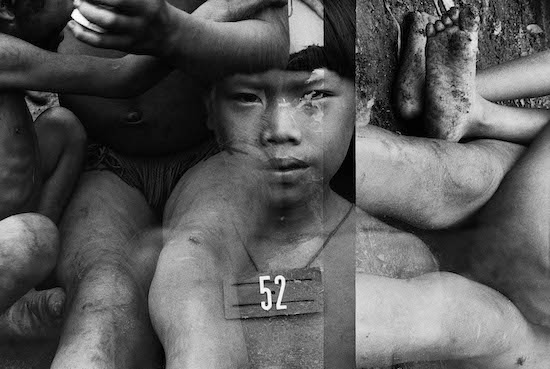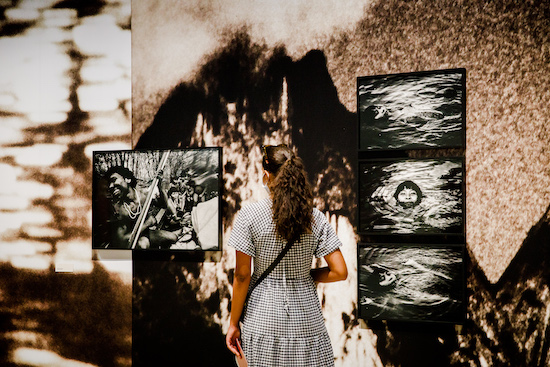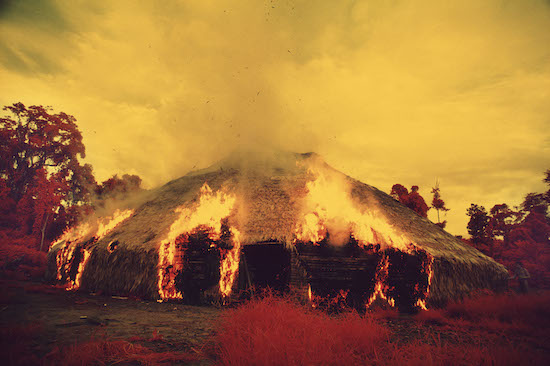Claudia Andujar. The Yanomami often burn down their yano
[collective house] when they migrate, when they want to escape from an epidemic, or when an important leader dies. Catrimani, 1972-76.
Infrared film. © Claudia Andujar
After a bit of fumbling with QR codes and hand sanitisers, I find myself engrossed in Claudia Andujar’s The Yanomami Struggle at the Barbican. It is a vast and impressive retrospective of her photojournalism documenting the life, thoughts, culture, and strife of the Yanomami people, a large and isolated community who live across 17.8 million hectares of rainforest spanning the Brazilian-Venezuelan border. More specifically, Andujar’s work explores their persecution by the Brazilian government, which has been an oppressive force since the 1940s. Since this time, the Yanomami have been subject to missionaries who have brought over diseases, destruction when a military government attempted to build a highway in the 1970s, and a gold-mining invasion since the 1980s – an incursion so devastating and violent it has been described by a Brazilian court as a genocide.
Andujar’s protective relationship with the people is entwined with her personal history with oppressive governments. Her paternal family were murdered in the Nazi concentration camps, and this sense of trauma has never left her. She still uses the surname of her ex-husband, Julio Andujar, a Spanish refugee, in an attempt to hide her Jewish identity. Speaking to The Guardian in 2020, she discussed her feelings of “want[ing] to help the Yanomami to survive like my family did not. I think my work is dependent on the suffering of my childhood. My friends from school all died in Auschwitz. Everyone. Nobody, nobody survived.”
While working as a photojournalist at the magazine Realidade in the 1950s, she focused on those who were ostracised at the time: drug addicts, homosexual people, sex workers, and migrants. It was her last project with the magazine, a cover photo featuring an indigenous Xikrin boy, that led her to a body of work that would last from 1971 to the present day.
At the Barbican, the room is tranquil, with only a few other gallery-goers, and we are met with a space filled with glorious pink, blue, orange, and red seen in images of the Amazonian landscapes to accent the black and white portraits of the Yanomami. It feels almost trite to mention, given the content, but the first thing I notice is that the photos themselves are gorgeous: perfect compositions of people laughing, relaxing, chatting, dancing, and living. At the start, we are confronted with images of lush landscapes. I am particularly grabbed by an image of fuchsia-leaved trees with a Yanomami collective house, just visible, in the centre. Amongst these landscapes, and the sea of portraits, images both quiet and loud, we can hear echoes of sound from videos dotted around the space, and there are patches of framed, felt-tip drawings by members of the Yanomami that fill the transformed Curve space.

Claudia Andujar : The Yanomami Struggle. Installation view. The Curve and The Pit 17 June – 29 August 2021 ©Tristan Fewings / Getty Images
It is Andujar’s departure from traditional styles of photojournalism that makes her work so potent. The images feel so familiar, you can see yourself, your family, your friends in the pictures of celebrations, of kids grinning at the camera. There is something about the proximity and beautiful celebrations of community that feel especially poignant in our time of such distance. Her experimental over-exposed, high-contrast stylistic approach adds to the energy of the images featured. In scenes of dancing, she puts Vaseline over the camera to allow the light to dance along with the people in the photos. They feel shaky, almost as if Andujar is dancing along herself.
I am relieved to first notice the joy in Andujar’s work. As a Jew myself, I find documentation from the Holocaust harrowing and awful; I find the hundreds of photos of emaciation to be so dehumanising. There is so much more power in the rare photos you see of people celebrating Jewish festivals and observing traditions of Shabbat in the camps and ghettos, and I find myself connecting with those images more. I can recognise myself in them. Like the Yanomami now, it was their defiance in continuing to respect their culture and tradition, a resistance against general conformity, that the Nazis abhorred, and there is so much beauty in people celebrating their own culture. Andujar’s work seems to thrive on this notion, and the photos seek to celebrate the very rich culture and tradition of the Yanomami people.
With members of the Yanomami’s permission, she invites us into their lives, and it is warm and full of love, energy, and excitement. In the exhibition guide, we are told that the Yanomami are reluctant to be photographed “as they fear that if a trace of them remains in the physical world after their death, their spirit will not fully ascend to the sky”. The trust that Andujar has built up with the community makes the sheer abundance of images a privilege to be able to experience.

Claudia Andujar. Aracá, Amazonas / Surucucus, From the
Marked series, double exposure, Roraima State, Brazil, 1983. © Claudia Andujar
To be able to learn about their culture, their beliefs and the intimacy of their traditions and joy feels almost like a privilege we shouldn’t be afforded, especially when we understand that much of the misery that has been bestowed upon the Yanomami due to a homogenised view of what “civilisation” means, who is deserving of land, and capitalist ideas of what needs to be done in said land.
Some of the most poignant pieces combine the humanising aspect of the work, the confrontation with the oppression, and the humanitarian efforts that were done to protect the community are seen in her series Vaccination and Health (1980–1987). At this time, the CCPY (Pro Yanomami Commission, founded by Andujar, Carlo Zacquini, Bruce Alert, and others in 1978) had started an urgent vaccination programme to tackle the measles epidemic that was having disastrous effects on the community. As the Yanomami do not traditionally have fixed names, but instead multiple names that change over time, the doctors created a system whereby they placed numbered tags and photographed each person wearing their numbered tag once they had been vaccinated. The exhibition points to its obvious parallels to the branding of the Jews during the Holocaust, both in their numbered tattoos and yellow stars. Andujar explores this discomfort in her writing, which is featured on the walls of the exhibition, talking about how Holocaust victims were branded for death; the Yanomami, in this case, are being branded for life. “It isn’t about justifying the mark placed around their necks, but rather about explaining that it refers to a sensitive and ambiguous area, one that may arouse discomfort and pain”.

Claudia Andujar : The Yanomami Struggle. Installation view. The Curve and The Pit 17 June – 29 August 2021 ©Tristan Fewings / Getty Images
What strikes me most about these images, all portraits in black and white set out in grids around the space, is that they feel like passport photos. I connect to the feeling of restlessness that is displayed in the photos; a sense of tedium, boredom, a few smiles, an impatience to get back to a normal life without this destructive disease. It strikes me that you would see a similar array of emotions at your local Covid vaccine centre.
My favourite pieces in the show were borne out of a roll of film from Andujar’s archive where the images had been accidentally superimposed. They include the medical identification portraits and the delivery of medicine and provisions to people in the Surucucus area. There is an enjoyable contrast between the sombre photos from the vaccination programme that are overlaid, ghost-like, with images of limbs, landscapes, and groups of people sitting waiting for their provisions. The faces from the vaccination programme overlay in a satisfying way, the light and shadow of the background complementing the light and dark of the foreground faces perfectly. It is the serendipity and embrace of experimental photographical techniques that add a special sense of personality to the artist’s work.
Despite the obvious socio-political motivations behind her vast archive, Andujar mentions while speaking to The Guardian in 2020 that she “does not think art has a political agency… This won’t change the attitude of Bolsonaro.” In a three-minute video of Brazilian president Jair Bolsonaro that is played just outside the main Curve space, we are confronted with the ugly truth of what this attitude is, and the source for a large amount of the community’s suffering. We hear him refer to the Yanomami, dismissively as “Indians”, who he feels don’t want to be “civilised” and as far as he is concerned, his government need the land more than these indigenous people do.
It is Andujar’s job to be the artist, and in doing this with the utmost reverence and respect, she has shown the true strength of artistic communication. Her goal is for the audience to connect with this community who have had to deal with oppression, invasion, and illness ever since, as Yanomami shaman and activist Davi Kopenawa puts it, “the white man arrived”. To say she achieves this would be an understatement.
Claudia Andujar’s The Yanomami Struggle is at the Barbican Curve Gallery until 29 August


